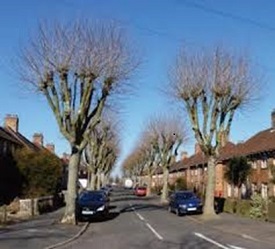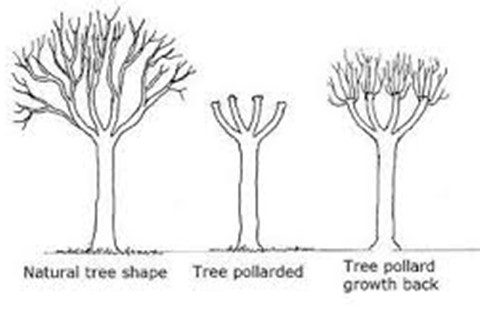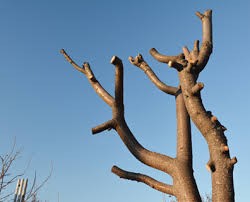Londoners will recognise pollarded trees as a feature of the urban landscape. Many of the street trees in cities are pollarded in an ongoing management scheme. As a professional London tree surgeon, I have first-hand experience of tree pollarding, and here I will share details of its origin, its benefits and the proper techniques for carrying it out.

Pollarded trees
Why are trees pollarded?
Trees are pollarded to limit their horizontal growth which prevents damage to overhead wires, stops them from obscuring street lights or obstructing the free passage of vehicles.
Pollarding reduces the amount of shade cast and limits the eventual size of the tree, as cutting back the spread of the tree also reduces root growth. It also reduces the amount of debris from twigs and dead leaves.
What is pollarding?
Pollarding is an age-old system of repeated methodical pruning in which the upper branches of a tree are removed. The result is increased growth at the cut points and a dense head of foliage and branches. A pollarded tree has characteristic knobs at the end of the main branches.

The stages of pollarding
In an urban garden, a tree can be pollarded to reduce shade and to keep the tree a suitable size for the space it occupies. Pollarding reduces root growth and so is a natural brake on the growth of the tree. The new growth on a pollarded tree can also be an attractive feature. Pollarding needs to be done with skill and care if the tree is not to be permanently damaged or disfigured. Take A Bough Tree Care offer a proficient and experienced service following a free quotation and discussion of your needs.
Pollarding or Topping?
Topping a tree creates many large open wounds which may result in decay, insect infestation and disease which can result in the death of the tree or its survival as an unsightly and unhealthy eyesore.
The loss of foliage starves the tree, which weakens the roots, reducing the tree’s structural strength. It also unbalances the root to crown ratio, disturbing the natural ratios and balances of nutrition production and storage
Pollarding uses the natural shape of the tree and is only done during the dormant period on suitable tree species, it causes no structural damage and the tree responds by producing healthy and stable stems from the cut sites.
Topping removes the tree’s apical meristem and causes the growth of waterspouts. The apical meristem is the area of cells capable of division and growth in the root and shoot tips in plants. Apical meristems give rise to the primary plant body and are responsible for the extension of the roots and shoots.
Waterspouts are dormant buds that grow quickly and erratically, growing rapidly upwards defeating the initial purpose of the topping. These branches are often poorly attached to the tree and create the risk of failure further damaging the tree and risking damage to anything nearby or even a risk to life.
Pollarded trees do not grow waterspouts but smaller firmly attached branches bush out the head of the tree.
What Can You Do if Your Tree Has Been Topped?
Expert tree surgery can often limit the damage caused by tree topping by crown restoration. Dead branches and poorly attached waterspouts are removed and better waterspouts are cultivated to form new branches. The process is carried out over several years but may eventually be able to reform the crown of the tree.
This process takes time and several prunings over a number of years but will eventually rejuvenate and reform the tree’s crown.

A topped tree
Pollarding or Coppicing?
Coppicing is an ancient technique whereby trees, usually hazel or chestnut are cut back to a stump at intervals to provide long straight branches for fencing, firewood and sometimes for making things like wooden spoons and baskets. Repeated coppicing of a tree creates a stool that can produce commercially important wood for a thousand years.
With pollarding the trees are only reduced above the top of the main stem, usually at least six feet or more above the ground. In rural areas, the new branches are also used as a sustainable source of wood but in urban areas, the main purpose is to limit the size of the tree.
Need Tree Pollarding?
If you are looking for someone to provide a tree pollarding service for South West London, give us a call by clicking above, or complete our contact form so we can get back to you about providing a free quotation – we will be very happy to hear from you!

